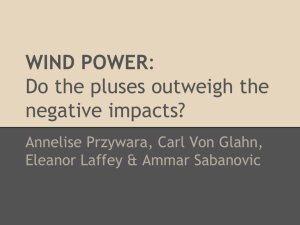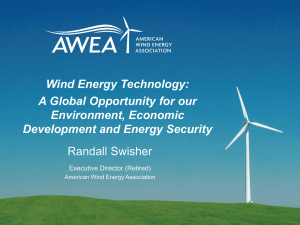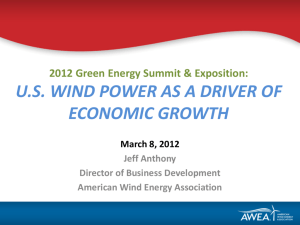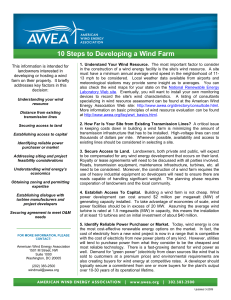AWEA Standard - Small Wind Certification
advertisement
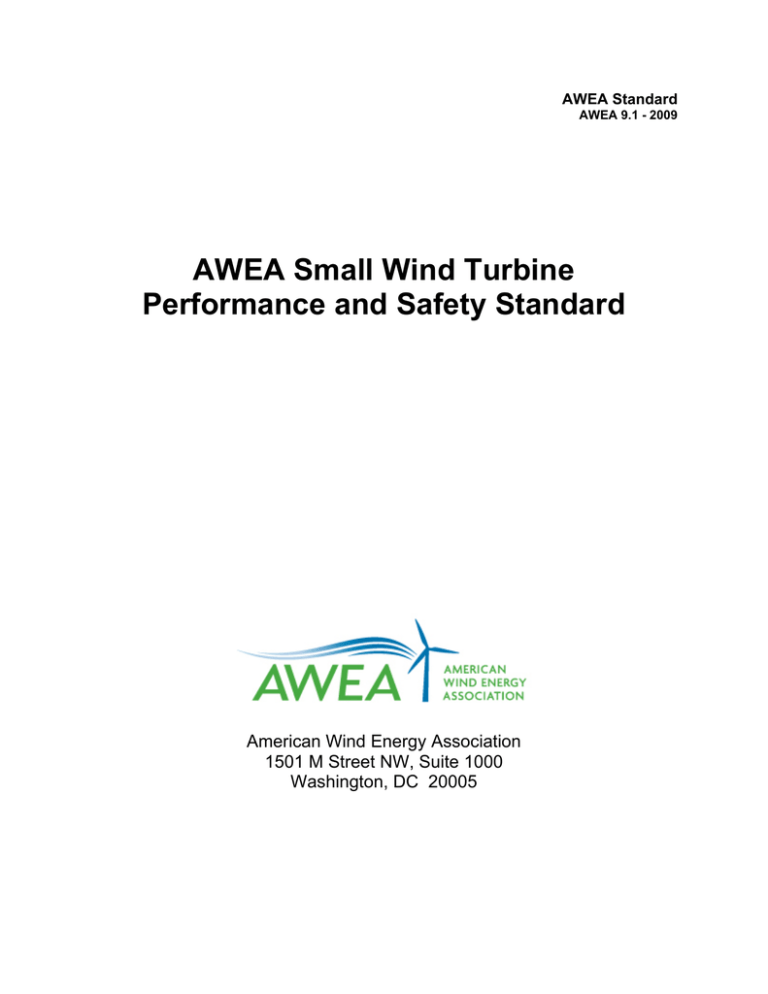
AWEA Standard AWEA 9.1 - 2009 AWEA Small Wind Turbine Performance and Safety Standard American Wind Energy Association 1501 M Street NW, Suite 1000 Washington, DC 20005 AWEA 9.1 - 2009 AMERICAN WIND ENERGY ASSOCIATION STANDARDS Standards promulgated by the American Wind Energy Association (AWEA) conform to the AWEA Standards Development Procedures adopted by the AWEA Board of Directors. The procedures are intended to ensure that AWEA standards reflect a consensus to persons substantially affected by the standard. The AWEA Standards Development Procedures are intended to be in compliance with the American National Standards Institute (ANSI) Essential Requirements. Standards developed under the AWEA Standards Development Procedures are intended to be eligible for adoption as American National Standards. AWEA standards may be revised or withdrawn from time to time. Contact AWEA to determine the most recent version of this standard. Published by: American Wind Energy Association 1501 M Street, NW, Suite 1000 Washington, DC 20005 202.383.2500 Copyright © 2009 American Wind Energy Association Attribution: No part of this standard may be reproduced or utilized in any form without proper attribution to the American Wind Energy Association. Credit should be acknowledged as follows: “AWEA Small Wind Turbine Performance and Safety Standard (AWEA Standard 9.1 – 2009) © The American Wind Energy Association.” Disclaimer AWEA Standards are developed through a consensus process of interested parties administered by the American Wind Energy Association. AWEA cannot be held liable for products claiming to be in conformance with this standard. Page - i - AWEA 9.1 - 2009 FOREWORD and BACKGROUND The Foreword and Background sections are included with this document for information purposes only, and are not part of the AWEA Small Wind Turbine Performance and Safety Standard. Foreword The goal of this standard is to provide meaningful criteria upon which to assess the quality of the engineering that has gone into a small wind turbine meeting this standard, and to provide consumers with performance data that will help them make informed purchasing decisions. The standard is intended to be written to ensure the quality of the product can be assessed while imposing only reasonable costs and difficulty on the manufacturer to comply with the standard. Background AWEA is recognized by the American National Standards Institute (ANSI) as an Accredited Standards Developer and the AWEA standard will be submitted for adoption as an American National Standard. This standard has been developed in a regimented ANSI process for “voluntary consensus standards” which requires participation from a range of representatives for manufacturers, technical experts, public sector agencies, and consumers. The draft that follows has been developed over the last five years in a process that involved over 60 participants, three meetings, 22 hours of conference calls, countless emails, a list serve, and five intermediate drafts. It represents hundreds of hours of detailed discussion, debate, compromise, revision, and formal response. The Canadian Wind Energy Association has been actively involved since the beginning and the British Wind Energy Association has now adopted and approved this standard almost word for word. The proposed standard was developed by the AWEA Small Wind Turbine Standard Subcommittee, which was chaired by Mike Bergey of Bergey Windpower Co. Members of the subcommittee have included the following people. Please note that there has been some turnover in the subcommittee, some positions have changed, and not all members were active (though they did receive the drafts and correspondence). Page - ii - AWEA 9.1 - 2009 Name Bill Colavecchio Lex Bartlett David Blittersdorf David Calley Jito Coleman David Laino Robert Preus Steve Turek Dr. Craig Hansen Robert Poore Ken Starcher Trudy Forsyth Brian Vick Brent Summerville Alex DePillis Affiliation Underwriters Laboratory Aeromag Earth Turbines Southwest Windpower Northern Power Endurance Abundant Ren. Energy Wind Turbine Industries Windward Engineering Global Energy Concepts Alternate Energy Institute National Renewable Energy Laboratory National Renewable Energy Laboratory National Renewable Energy Laboratory USDA/Bushland SWCC Wisconsin Energy Office Jennifer Harvey Cassandra Kling Dora Yen Paul Gipe Mike Klemen Heather Rhoads Weaver Mick Sagrillo Brad Cochran Samit Sharma Svend de Bruyn NYSERDA New Jersey BPU California Energy Comm. California North Dakota Washington Wisconsin Colorado Canada Deltronics Jim Green Hal Link Stakeholder Category Certifying Agency Manufacturer Manufacturer / Consumer Manufacturer Manufacturer Manufacturer Manufacturer Manufacturer Technical Expert Technical Expert Technical Expert Researcher / Technical Expert Researcher / Technical Expert Researcher / Technical Expert Technical Expert Technical Expert State Energy Office / Consumer State Energy Office State Energy Office State Energy Office Consumer Consumer Consumer / AWEA Consumer Interested Party CanWEA Canadian Industry Other participants in the development of this proposed standard have included (as they were affiliated at the time of their involvement): Mark Bastasch Ralph Belden, Synergy Power Michael Blair David Blecker, Seventh Generation Bob Clarke, Ventera Energy Dean Davis, Windward Engineering John Dunlop, AWEA Henry DuPont, Lorax Page - iii - AWEA 9.1 - 2009 Mike Gray, Gray Engineering Jeffrey Haase, State of Minnesota Tod Hanley, Bergey Windpower Robert Hornung, CanWEA Arlinda Huskey, NREL Dale Jones, Geocorp Dan Juhl, DanMar Steve Kalland, NCSU Peter Konesky, State of Nevada Andy Kruse, Southwest Windpower Jean-Daniel Langlios Amy Legere, Southwest Windpower Malcomb Lodge, Entegrity Wind Charles Newcomb, Entegrity Wind Chuck Maas Dennis Makeperce, E.R.D. Tom Maves, State of Ohio Michael Mayhew Richard Michaud, US-DOE Jacques Michel, E.R.D. Paul Migliore, NREL Lawrence Mott, Earth Turbines Jennifer Oliver, Southwest Windpower Philippe Quinet Doug Selsam, Selsam Engineering David Sharman, Ampair / BWEA Robert Sherwin, Vermont Wind Power Int’l Larry Sherwood, IREC P.V. Slooten Eric Stephens Brian Smith, NREL Jeroen van Dam, NREL / UL David VanLuvanee Jane Weismann, IREC Kyle Wetzel, Consultant Sean Whittaker, CanWEA Page - iv - AWEA 9.1 - 2009 AWEA Small Wind Turbine Performance and Safety Standard Table of Contents Section Page 1. General Information 1 2. Performance Testing 4 3. Acoustic Sound Testing 4 4. Strength and Safety 5 5. Duration Test 6 6. Reporting 6 7. Labeling 7 8. Changes to Certified Products 8 9. References and Appendices 8 Appendix A Addendum Page - v - AWEA 9.1 - 2009 AWEA Small Wind Turbine Performance and Safety Standard 1 General Information 1.1 Purpose This standard was created by the small wind turbine industry, scientists, state officials, and consumers to provide consumers with realistic and comparable performance ratings and an assurance the small wind turbine products certified to this standard have been engineered to meet carefully considered standards for safety and operation. The goal of the standard is to provide consumers with a measure of confidence in the quality of small wind turbine products meeting this standard and an improved basis for comparing the performance of competing products. 1.2 Overview 1.2.1 This performance and safety standard provides a method for evaluation of wind turbine systems in terms of safety, reliability, power performance, and acoustic characteristics. This standard for small wind turbines is derived largely from existing international wind turbine standards developed under the auspices of the International Electrotechnical Commission (IEC). Specific departures from the IEC standards are provided to account for technical differences between large and small wind turbines, to streamline their use, and to present their results in a more consumer-friendly manner. 1.2.2 No indirect or secondary standards references are intended. Only standards directly referenced in this standard are embodied. 1.3 Scope 1.3.1 This standard generally applies to small wind turbines for both on-grid and off-grid applications. 1.3.2 This standard applies to wind turbines having a rotor swept area of 200 m2 or less. In a horizontal-axis wind turbine this equates to a rotor diameter of ~ 16 m (~ 52 ft) 1.3.3 A turbine system includes the wind turbine itself, the turbine controller, the inverter, if required, wiring and disconnects, and the installation and operation manual(s). 1.3.4 In cases where several variations of a turbine system are available, it is expected that a full evaluation would be performed on one of the most representative arrangements. Other variations, such as different power output forms, need only be evaluated or tested in the ways in which they are different from the base configuration. For example, a wind turbine available in both grid-intertie and battery charging versions would need Page - 1 - AWEA 9.1 - 2009 separate performance tests if both versions were to be certified, but would not need a separate safety evaluation in most cases. 1.3.5 Except as noted in Sections, 4.2, 4.5, 5.2.3, 5.2.4, 5.2.5 and 6.1.8, towers and foundations are not part of the scope of this standard because it is assumed that conformance of the tower structure to the International Building Code, Uniform Building Code or their local equivalent will be required for a building permit. 1.4 Compliance 1.4.1 Certification to this standard shall be done by an independent certifying agency such as the Small Wind Certification Council (SWCC) or a Nationally Recognized Testing Laboratory (NRTL). Self-certification is not allowed. 1.4.2 It is the intent of this standard to allow test data from manufacturers, subject to review by the certifying agency. 1.4.3 Compliance with this standard for the purposes of advertising or program qualification, or any other purpose, is the responsibility of the manufacturer. 1.5 Definitions 1.5.1 Definitions contained in IEC 61400-12-1, ed.1 (Performance); IEC 6140011, ed.2 (Acoustic Noise); and IEC 61400-2, ed.2 (Design Requirements) are hereby incorporated by reference. 1.5.2 Additional Definitions 1.5.2.1 AWEA Rated Power: The wind turbine’s power output at 11 m/s (24.6 mph) per the power curve from IEC 61400-12-1, except as modified in Section II of this Standard. 1.5.2.2 AWEA Rated Annual Energy: The calculated total energy that would be produced during a one-year period at an average wind speed of 5 m/s (11.2 mph), assuming a Rayleigh wind speed distribution, 100% availability, and the power curve derived from IEC 61400-12-1 (sea level normalized), except as modified in Section II of this Standard. 1.5.2.3 AWEA Rated Sound Level: The sound level that will not be exceeded 95% of the time, assuming an average wind speed of 5 m/s (11.2 mph), a Rayleigh wind speed distribution, 100% availability, and an observer location 60 m (~ 200 ft.) from the rotor center 1 , calculated from IEC 61400-11 test results, except 1 Appendix A contains guidance on obtaining sound levels for different observer locations and background sound levels. Page - 2 - AWEA 9.1 - 2009 as modified in Section III of this Standard. 1.5.2.4 Cut-in Wind Speed: The first wind speed bin in the averaged power curve that is positive. 1.5.2.5 Cut-out Wind Speed: The wind speed above which, due to control function, the wind turbine will have no power output. 1.5.2.6 Maximum Power: The maximum one-minute average power output a wind turbine in normal steady-state operation will produce (peak instantaneous power output can be higher). 1.5.2.7 Maximum Voltage: The maximum instantaneous voltage the wind turbine will produce in operation including open circuit conditions. 1.5.2.8 Maximum Current(s): The maximum instantaneous current(s) the wind turbine will produce on each side of the system’s control or power conversion electronics. 1.5.2.9 Overspeed Control: The action of a control system, or part of such system, which prevents excessive rotor speed. 1.5.2.10 Power Form: Physical characteristics which describe the form in which power produced by the turbine is made deliverable to the load. 1.5.2.11 Rotor Swept Area: Projected area perpendicular to the wind direction swept by the wind turbine rotor in normal operation (un-furled position). If the rotor is ducted, the area inscribed by the ducting shall be included. 1.5.2.12 Turbulence Intensity: The standard deviation of wind speed divided by the mean wind speed based on 1-minute averaged data that is sampled at 1 Hz. 1.6 Units 1.6.1 The primary units shall be SI (metric). The inclusion of secondary units in the English system is recommended [e.g., 10 m/s (22.4 mph)]. 1.7 Test Turbine and Electronics 1.7.1 Tested wind turbines and their associated electronics shall conform to the specific requirements of the governing IEC wind generator standard referenced for each test, but incorporating any amendments contained in this standard. Page - 3 - AWEA 9.1 - 2009 2 Performance Testing 2.1 Wind turbine performance shall be tested and documented in a test report per the latest edition of IEC 61400-12-1, Annex H, but incorporating the additional guidance provided in this section. 2.1.1 In item b, battery banks are considered to be part of the wind turbine system for grid-connected wind turbines that incorporate a battery bank. 2.1.2 In item e, the total wire run length, measured from the base of the tower, must be at least 8 rotor diameters and the wiring is to be sized per the manufacturer’s installation instructions. 2.1.3 In item n, the database shall include 10 minutes of data for all wind speeds at least 5 m/s beyond the lowest wind speed at which power is within 95% of Maximum Power (or when sustained output is attained). 3 Acoustic Sound Testing 3.1 Wind turbine sound levels shall be measured and reported in accordance with the latest edition of IEC 61400-11 ed.2, but incorporating the additional guidance provided in this section. 3.1.1 The averaging period shall be 10-second instead of 1-minute. 3.1.2 Measuring wind speed directly instead of deriving wind speed through power is the preferred method. 3.1.3 The method of bins shall be used to determine the sound pressure levels at integer wind speeds. 3.1.4 It shall be attempted to cover as wide a wind speed range as possible, as long as the wind screen remains effective. 3.1.5 A description shall be provided of any obvious changes in sound at high wind speeds where overspeed protection becomes active (like furling or pitching). 3.1.6 A tonality analysis is not required, but the presence of prominent tones shall be observed and reported. Page - 4 - AWEA 9.1 - 2009 4 Strength and Safety 4.1 Except as noted below, mechanical strength of the turbine system shall be assessed using either the simple equations in Section 7.4 of IEC 61400-2 ed.2 in combination with the safety factors in Section 7.8, or the aeroelastic modeling methods in the IEC standard. Evaluation of, as a minimum, the blade root, main shaft and the yaw axis (for horizontal axis wind turbines) shall be performed using the outcome of these analyses. A quick check of the rest of the structure for obvious flaws or hazards shall be done and if judged needed, additional analysis may be required. 4.2 Variable speed wind turbines are generally known to avoid harmful dynamic interactions with towers. Single/dual speed wind turbines are generally known to have potentially harmful dynamic interactions with their towers. Therefore, in the case of single/dual speed wind turbines, such as those using either one or two induction generators, the wind turbine and tower(s) must be shown to avoid potentially harmful dynamic interactions. A variable speed wind turbine with dynamic interactions, arising for example from control functions, must also show that potentially harmful interactions are likewise avoided. 4.3 Other safety aspects of the turbine system shall be evaluated including: 4.3.1 procedures to be used to operate the turbine; 4.3.2 provisions to prevent dangerous operation in high wind; 4.3.3 methods available to slow or stop the turbine in an emergency or for maintenance; 4.3.4 adequacy of maintenance and component replacement provisions; and 4.3.5 susceptibility to harmful reduction of control function at the lowest claimed operating ambient temperature. 4.4 A Safety and Function Test shall be performed in accordance with Section 9.6 of IEC 61400-2 ed.2. 4.5 The manufacturer shall submit design requirements for towers including: 4.5.1 mechanical and electrical connections; 4.5.2 minimum blade/tower clearance; 4.5.3 maximum tower top loads; and 4.5.4 maximum allowable tower top deflection. Page - 5 - AWEA 9.1 - 2009 5 Duration Test 5.1 To establish a minimum threshold of reliability, a duration test shall be performed in accordance with the IEC 61400-2 ed.2 Section 9.4. 5.2 Changes and additional clarifications to this standard include: 5.2.1 The test must include at least 25 hours in wind speeds of 15 m/s (33.6 mph) and above. 5.2.2 Minor repairs are allowed, but must be reported. 5.2.3 If any major component such as blades, main shaft, generator, tower, controller, or inverter is replaced during the test, the test must be restarted. 5.2.4 The turbine and tower shall be observed for any tower dynamics problems during the duration test and the test report shall include a statement of the presence or absence of any observable problems. 5.2.5 The tower used for the duration test must comply with the tower design requirements described in section 4.5. 6 Reporting and Certification 6.1 The test report shall include the following information: 6.1.1 Summary Report, containing a power curve, an Annual Energy Production curve, and the measured sound pressure levels (Section 9.4 of IEC 61400-11 ed.2). The report is intended to be publicly available once approved by the certifying agency. 6.1.2 Power Performance Test Report 6.1.3 Acoustic Test Report 6.1.4 The AWEA Rated Annual Energy 6.1.5 The AWEA Rated Sound Level 6.1.6 The AWEA Rated Power 6.1.7 Wind Turbine Strength and Safety Report 6.1.8 The tower design requirements shall be reported 6.1.9 Duration Test Report 6.2 The manufacturers of certified wind turbines must abide by the labeling requirements of the certifying agency. Page - 6 - AWEA 9.1 - 2009 7 Labeling 7.1 The AWEA Rated Annual Energy (AWEA RAE) shall be stated in any label, product literature or advertising in which product specifications are provided. 7.1.1 The AWEA RAE shall be rounded to no more than 3 significant figures. 7.2 The manufacturer shall state the AWEA Rated Power if a rated power is specified. 7.3 The manufacturer shall state the AWEA Estimated Sound Level if a sound level is specified. 7.4 Other performance data recommended to be stated in specifications about the turbine are: 7.4.1 Cut-in Wind Speed 7.4.2 Cut-out Wind Speed 7.4.3 Maximum Power 7.4.4 Maximum Voltage 7.4.5 Maximum Current(s) 7.4.6 Overspeed Control 7.4.7 Power Form Page - 7 - AWEA 9.1 - 2009 8 Changes to Certified Products 8.1 It is anticipated that certified wind turbines will occasionally be changed to provide one form of improvement or another. In some cases such changes will require review by the certifying agency and possible changes to the certified product parameters. The following guidance is provided concerning when product changes will require certifying agency review: 8.1.1 Any changes to a certified wind turbine that will have the cumulative effect of reducing AWEA Rated Power or AWEA Rated Annual Energy by more than 10%, or that will raise the AWEA Rated Sound Level by more than 1 dBA will require retesting and recertification by the certifying agency. Only those characteristics of the wind turbine affected by the design change(s) would be reviewed again. 8.1.2 Any changes to a certified wind turbine that could reduce the strength and safety factors by 10%, or increase operating voltages or currents by 10%, will require resubmission of the Wind Turbine Strength and Safety Report and recertification by the certifying agency. 8.1.3 Any changes to a certified wind turbine that could materially affect the results of the Duration Test will require retesting, submission of a new Duration Test Report, and recertification by the certifying agency. 8.2 The manufacturer is required to notify the certifying agency of all changes to the product, including hardware and software, for the life of the turbine certification. The certifying agency will determine whether the need for retesting and additional review under the guidelines provided in Section 8.1. 8.3 The use of Engineering Change Orders or their equivalent is recommended. 9 References and Appendices 9.1 References 9.1.1 Evaluation Protocol for Small Wind Systems, Rev. 3. NREL internal document 9.1.2 IEC 61400-12-1 ed.1, Wind Turbines – Part 12-1: Power performance measurements of electricity producing wind turbines 9.1.3 IEC 61400-11 ed.2, Wind turbine generator systems - Part 11: Acoustic noise measurement techniques 9.1.4 IEC 61400-2, ed.2, Wind Turbines – Part 2: Design requirements of small wind turbines Page - 8 - AWEA 9.1 - 2009 Appendix A Sound Levels for Different Observer Locations and Background Sound Levels The AWEA Rated Sound Level is calculated at a distance of 60 meters from the rotor hub and excludes any contribution of background sound. As the distance from the turbine increases, the background sound becomes more dominant in determining the overall sound level (turbine plus background). Background sound levels depend greatly on the location and presence of roads, trees, and other sound sources. Typical background sound levels range from 35 dBA (quiet) to 50 dBA (urban setting) Equation 1 can be used to calculate the contribution of the turbine to the overall sound level using the AWEA Rated Sound Level. Equation 2 can be used to add the turbine sound level to the background sound level to obtain the overall sound level. ( turbine sound level = L AWEA + 10 log( 4π 60 2 ) − 10 log 4πR 2 ) (1) Where: LAWEA is the AWEA Rated Sound Level [dBA]. R is the observer distance from the turbine rotor center [m] overall sound level = 10 log(10 turbine level 10 + 10 background level 10 ) (2) Table 1 Overall Sound Levels at Different Locations for an AWEA Rated Sound Level of 40 dBA Distance LAWEA: 40 dBA from rotor background noise level (dBA): center [m] 30 35 40 45 50 10 20 30 40 50 60 70 80 100 150 200 55.6 49.6 46.1 43.7 41.9 40.4 39.2 38.2 36.6 34.1 32.8 55.6 49.7 46.4 44.1 42.4 41.2 40.2 39.4 38.3 36.8 36.1 55.7 50.0 47.0 45.1 43.9 43.0 42.4 41.9 41.3 40.6 40.4 55.9 50.9 48.6 47.3 46.6 46.2 45.9 45.7 45.5 45.2 45.1 56.6 52.8 51.5 50.9 50.6 50.4 50.3 50.2 50.2 50.1 50.0 Page - 1 - AWEA 9.1 - 2009 Table 2 Overall Sound Levels at Different Locations for an AWEA Rated Sound Level of 45 dBA Distance LAWEA: 45 dBA from rotor background noise level (dBA): center [m] 30 35 40 45 50 10 20 30 40 50 60 70 80 100 150 200 60.6 54.6 51.1 48.6 46.7 45.1 43.8 42.7 40.9 37.8 35.9 60.6 54.6 51.1 48.7 46.9 45.4 44.2 43.2 41.6 39.1 37.8 60.6 54.7 51.4 49.1 47.4 46.2 45.2 44.4 43.3 41.8 41.1 60.7 55.0 52.0 50.1 48.9 48.0 47.4 46.9 46.3 45.6 45.4 60.9 55.9 53.6 52.3 51.6 51.2 50.9 50.7 50.5 50.2 50.1 Table 3 Overall Sound Levels at Different Locations for an AWEA Rated Sound Level of 50 dBA Distance LAWEA: 50 dBA from rotor background noise level (dBA): center [m] 30 35 40 45 50 10 20 30 40 50 60 70 80 100 150 200 65.6 59.5 56.0 53.5 51.6 50.0 48.7 47.6 45.7 42.3 40.0 65.6 59.6 56.1 53.6 51.7 50.1 48.8 47.7 45.9 42.8 40.9 65.6 59.6 56.1 53.7 51.9 50.4 49.2 48.2 46.6 44.1 42.8 65.6 59.7 56.4 54.1 52.4 51.2 50.2 49.4 48.3 46.8 46.1 65.7 60.0 57.0 55.1 53.9 53.0 52.4 51.9 51.3 50.6 50.4 Table 4 Overall Sound Levels at Different Locations for an AWEA Rated Sound Level of 55 dBA Distance LAWEA: 55 dBA from rotor background noise level (dBA): center [m] 30 35 40 45 50 10 20 30 40 50 60 70 80 100 150 200 70.6 64.5 61.0 58.5 56.6 55.0 53.7 52.5 50.6 47.1 44.7 70.6 64.5 61.0 58.5 56.6 55.0 53.7 52.6 50.7 47.3 45.0 70.6 64.6 61.1 58.6 56.7 55.1 53.8 52.7 50.9 47.8 45.9 70.6 64.6 61.1 58.7 56.9 55.4 54.2 53.2 51.6 49.1 47.8 70.6 64.7 61.4 59.1 57.4 56.2 55.2 54.4 53.3 51.8 51.1 Page - 2 - AWEA 9.1 - 2009 60 30 dBA 35 dBA 40 dBA 45 dBA 50 dBA Overall Sound level [dBA] 55 50 45 40 35 30 0 20 40 60 80 100 120 140 160 180 200 Distance from rotor center [m] Figure 1 Sound levels as a function of distance and background noise levels for AWEA rated sound level of 40 dBA 65 30 dBA 35 dBA 40 dBA 45 dBA 50 dBA Overall Sound level [dBA] 60 55 50 45 40 35 0 20 40 60 80 100 120 140 160 180 200 Distance from rotor center [m] Figure 2 Sound levels as a function of distance and background noise levels for AWEA rated sound level of 45 dBA Page - 3 - AWEA 9.1 - 2009 70 30 dBA 35 dBA 40 dBA 45 dBA 50 dBA 65 Overall Sound level [dBA] 60 55 50 45 40 35 0 20 40 60 80 100 120 140 160 180 200 Distance from rotor center [m] Figure 3 Sound levels as a function of distance and background noise levels for AWEA rated sound level of 50 dBA 75 30 dBA 35 dBA 40 dBA 45 dBA 50 dBA 70 Overall Sound level [dBA] 65 60 55 50 45 40 0 20 40 60 80 100 120 140 160 180 200 Distance from rotor center [m] Figure 4 Sound levels as a function of distance and background noise levels for AWEA rated sound level of 55 dBA Page - 4 -
